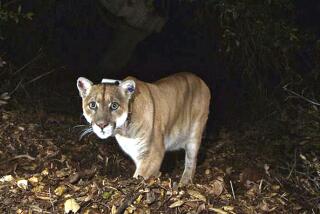Protected Land to Go Public
- Share via
Behind a padlocked gate near Irvine, 214 acres of preserved and restored coastal sage scrub provide breeding habitat for the endangered gnatcatcher. Buckwheat, sage, cactuses and other native plants cover more than two-thirds of the site; red-tailed hawks swerve overhead, and blue herons rest at the water’s edge.
The site--adjoining the Siphon Reservoir on Irvine Co. land--is now protected land, set aside by the Transportation Corridor Agencies to satisfy regulatory requirements that it make up for sensitive habitat destroyed during the construction of the Foothill and Eastern toll roads. Few people, aside from toll-road officials, wildlife workers and the occasional scientist, have ever seen it.
But starting this spring, that site and seven others will be open to the public on a limited basis. Toll-road officials plan to offer some access to 2,037 acres of protected wilderness areas spread throughout South County to allow scientific research, guided hikes and educational events.
Activists say the move is merely a publicity stunt using isolated South County mitigation sites to deflect attention from the environmental toll the roads have taken on open space--a charge that toll officials vehemently deny.
“We can’t just build the roads--we have to be mindful of the environment,” said TCA spokeswoman Lisa Telles. “We have to put together a program to compensate for the impacts. In the planning, we created these resources.”
The agency’s eight mitigation sites include portions of a San Diego saltwater marsh, the Bonita Creek wetlands, Coyote Canyon, the San Joaquin Hills, the Canada Gobernadora wetlands, the Siphon Reservoir site, the Limestone Canyon wetlands and Chiquita Canyon.
A biologist-led tour program will be in place by spring, and public access will be expanded in the future to include bird-watching in the wetlands and other activities, Telles said. She envisions a variety of activities at each site and during different times of year, depending on the area’s physical attributes and habitat requirements. For example, hiking will be limited near the gnatcatchers’ nesting habitat at the Siphon Reservoir site during the endangered bird’s breeding season.
“We don’t want a lot of people traipsing through here,” Telles said. “The No. 1 purpose [of these areas] is for the biological resources. Certainly, we will not do anything that will impact that.”
Environmentalists say it’s too little, too late.
“If they really cared about it, they wouldn’t have carved the landscape up in the first place,” said Claire Schlotterbeck, president of Hills for Everyone, the group that helped create Chino Hills State Park.
“The mitigation they did was kind of window dressing,” said Dan Silver of the Endangered Habitats League. Although public access is fine, he said, the land “never really mitigated for the horrible impacts of the project.”
Toll-road officials counter that in addition to compensating for damage, mitigation sites were often left more environmentally sound than in their original state.
The Bonita Creek wetlands “is an excellent example of restoration making something better than it was before,” said Laura Eisenberg, principal of resource management at the TCA.
The 21-acre site was part of the mitigation for wetlands destruction during construction of the San Joaquin Hills toll road.
“It was a concrete ditch before we brought it back to a wetland with a natural bottom and everything,” Telles said.
Eisenberg added: “It’s an opportunity to educate about the environment. [Critics say] restoration can’t be done. It can be done, and we have a very serious commitment to environmental protection.”
The Bonita Creek site is sandwiched between the San Joaquin Hills toll road and housing construction by the Irvine Co. The sounds of passing traffic and bulldozers backing up are heard along with the sounds of nature.
Elizabeth Lambe, regional representative for the Sierra Club, questioned the idea of hiking near urban areas. Many of the mitigation sites are narrow strips of land bordering the toll roads.
“The toll roads caused enormous environmental damage, they don’t help with the transportation needs and obviously they don’t meet projected revenue numbers, so in order to put a good face on a bad project, they’re offering up tours that basically aren’t meaningful,” said Lambe, who is also coordinator of the Friends of the Foothills coalition.
Schlotterbeck added: “We’ve created a bunch of little island habitats. We’re pretending we’ve saved the land, but over the long term, these islands are going to collapse. That’s just sort of a given.”
But toll-road officials point out that many sites, such as the 50-acre Limestone Regional Park, are adjacent to larger protected conservation areas.
Eisenberg added that the environmental value of these areas is evident--consider the 15 pairs of gnatcatchers that nested at the Siphon Reservoir site and produced 32 fledglings.
“That’s a very good indicator of how well the ecosystem is functioning,” she said. “We’ve tried very hard to make sure each mitigation project fits within the larger ecosystem.”
(BEGIN TEXT OF INFOBOX / INFOGRAPHIC)
Balancing Act
Orange County’s toll-road builder plans to open to the public about 2,000 acres of open space set aside to make up for habitat destroyed by road construction. Environmentalists criticize the preserves as grossly inadequate.
Source: Transportation Corridor Agencies
More to Read
Sign up for Essential California
The most important California stories and recommendations in your inbox every morning.
You may occasionally receive promotional content from the Los Angeles Times.














